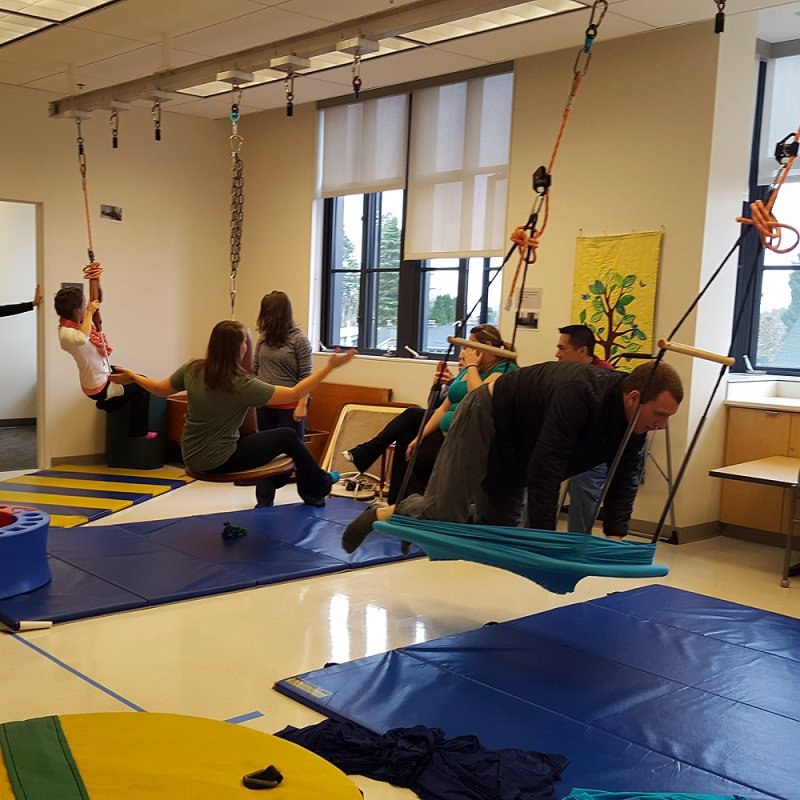 Alexander Lopiccolo teaches a sensory and motion therapy workshop for occupational therapists at the University of Puget Sound. Photo: Alexander Lopiccolo
Alexander Lopiccolo teaches a sensory and motion therapy workshop for occupational therapists at the University of Puget Sound. Photo: Alexander Lopiccolo
Alexander Lopiccolo, 30, of Wauna, is an occupational therapist who helps children with a range of behavioral, social and physical challenges. His patients may be autistic or have attention deficit disorder or be hyperactive, but he focuses on treating one element they often have in common: sensory processing disorder.
Recognizing and treating SPD is a recent but growing part of occupational therapy. “It’s on the rise, kind of like autism,” Lopiccolo said. “Every child with autism has a form of SPD, but not everyone with SPD is on the autism spectrum.”
Lopiccolo sees 30 or more children, ages 3 to 15, each week at Harbor Children’s Therapy in Gig Harbor. Many have been referred by their pediatrician because of a behavioral issue. “A lot of kids look neurotypical, but we see flaws in their sensory processing,” he said. “Hyperactive arousal state or hyporeactive, low muscle tone, poor coordination, poor posture. Most of the time, they’re having a lot of sensory issues.”
SPD is a condition that affects a person’s ability to process and respond to stimuli, whether it’s physical, tactile, visual, auditory or olfactory. A person with SPD can have trouble understanding the relative position of the parts of their own body or how it relates to objects around them, and what level of strength is needed to perform simple tasks. They can develop phobias or act out in seemingly unpredictable ways.
“In hyperactive kids, where we see hyperarousal and impulsivity, they need intensity to help modulate their responses,” Lopiccolo said. “By getting intense input through crashing, through flinging, by doing heavy work, you help modulate (their) central nervous system.”
Lopiccolo creates environments that let children do just that—crashing, flinging and “heavy work”—in safe but challenging indoor sensory gyms with an array of obstacles, swings and hammocks. There are also soft, hanging tents or tunnels for children who are hypersensitive to stimuli.
“The central nervous system is the bottom of the pyramid and as therapists, we treat from the bottom up,” Lopiccolo said. “Behavioral and academics are at the top of the pyramid. What we want to see as parents is treatment for the behavior, but when you treat the central nervous system, you see the best academic/behavioral/social interactive responses.”
Lopiccolo not only employs these techniques at his full-time job, he teaches them to other therapists in a workshop called King of Swings: Hands-on Sensory Motor Workshop. He also builds customized multisensory gyms in private homes for parents to use with their children. His family just moved to the KP from Colorado six months ago and he has already installed six gyms in the area with Stan Riddle, a local contractor.
A typical home sensory gym includes strong ceiling hooks to suspend four-point, multilayered Lycra hammocks, a low plank to glide on and a trapeze or soft tents. The system is simple, but allows for a variety of objects that can be easily installed, removed or adjusted, and includes lots of padding for the floor.
“I teach them exercises in the gym that they can use as therapeutic interventions at home,” Lopiccolo said. “It looks like it’s just great exercise, but really we’re building new neural pathways.”
Children and parents learn to navigate increasingly challenging obstacles or take time out to relax in a covered hammock free from distraction, or just “get the wiggles out.” But there’s more to it than that: “You’re forcing your brain to work at a higher level,” Lopiccolo said. “If you’re able to do a more complex activity, the lower motor process of activities of daily living are easier to master.”
Karen Jones of Allyn installed a gym for her 4-year-old son, Austin.
“He was diagnosed with autism and we were referred to occupational therapy,” she said. “We found out what he craves is motion.”
Jones started the therapy when Austin was 3 years old. “He was not redirectable and had a lot of tantrums,” she said. “Now, he doesn’t get into trouble so much because he’s able to control his emotions more.
“He goes on swings and sensory hammocks that feed his different senses,” she said. “He plays with different things for touching, strengthening muscles. The more he uses it, the better he feels.”
Austin will be reevaluated for autism in another six months or so. “You know, the diagnosis is what it is,” Jones said. “There’s been a huge improvement in his behavior.”
UNDERWRITTEN BY THE FUND FOR NONPROFIT NEWS (NEWSMATCH) AT THE MIAMI FOUNDATION, THE ANGEL GUILD, ADVERTISERS, DONORS AND PEOPLE WHO SUPPORT INDEPENDENT, NONPROFIT LOCAL NEWS